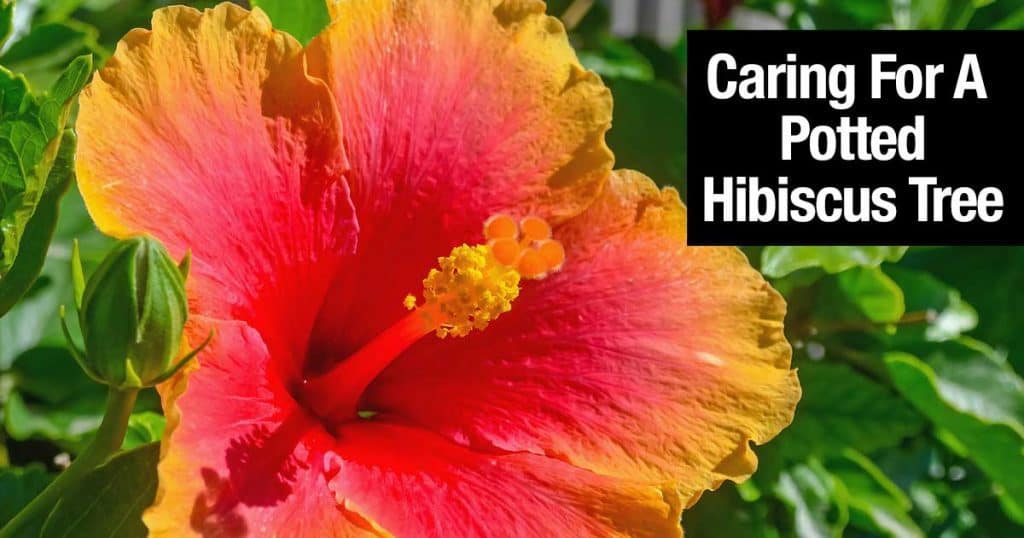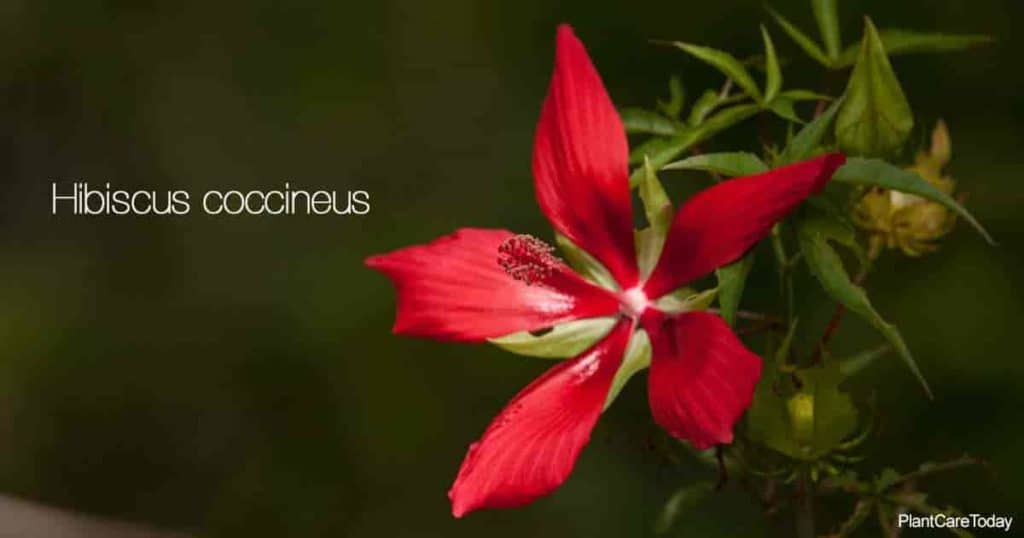Hibiscus is a versatile and varied genus of flowering plants in the mallow family Malvaceae. In the United States Hibiscus is pronounced [high-BISS-kiss], in the United Kingdom [hih-BISS-kiss].
Its name comes from the Greek ibiskos, the name the ancient Greek botanist and physician Pedanius Dioscorides gave to the marshmallow plant. Hibiscus is also known as rose mallow. There are over 200 varieties of Hibiscus, including annuals, perennials, and woody shrubs.
Most of these varieties fall into two main categories:
Tropical Hibiscus originated in Asia and the Pacific Islands. It requires a consistently warm climate.
Hardy hibiscus originates in North America. It can withstand winters and other extreme conditions. More on Hibiscus Winter Care.
The Features of Hibiscus and How It’s Used
Hibiscus plants have large, trumpet-shaped flowers, five petals, and conspicuous orange anthers. The colors of Hibiscus flowers depend on the variety and may change throughout the plant’s lifetime.
Hibiscus green leaves and sometimes variegated, are large and often lobed. They usually have spiny pollen and fruit enclosed in capsules.
You’ll find Hibiscus plants often used in landscaping and other ornamental purposes. Hibiscus grown in pots or planters tend to do well planted in a well-drained soil. Some growers create a strikingly unique, braided Hibiscus tree combining varieties with different colored flowers.
In temperate climates, tropical Hibiscus varieties need to move inside before a frost.
Make sure the pot drains well since hibiscus roots will rot from overwatering.
In addition to landscaping, some varieties of Hibiscus are used for food and beverage.
One type of Hibiscus, Hibiscus sabdariffa, or roselle, is used to make a popular Hibiscus tea in countries worldwide. Serve the tea hot or cold, it has a tart flavor and is high in vitamin C.
Types of Hibiscus
There are over 200 varieties of Hibiscus. Let’s look at some of the most popular ones.
Hibiscus Rosa-Sinensis (Chinese Hibiscus)
The Chinese Hibiscus is the most prominent variety of tropical Hibiscus. It has many different common names, including:
- Hawaiian Hibiscus
- China Rose
- Tropical Hibiscus
This evergreen Hibiscus bush, shrub, or tree blooms all year round in tropical climates or areas with no frost. The petals have a slight ruffle and are:
- White
- Bright Pink
- Red
- Golden Yellow
- Orange
- Purple
… and may change color as the plant grows older.
Do hibiscus need full sun? Hibiscus requires direct sun and slightly acidic soil. It is more sensitive to changes in conditions than other Hibiscus varieties. Details on Hibiscus Sun Requirements.
Hibiscus Syriacus (Rose of Sharon)
In contrast to the temperamental Chinese Hibiscus, Hibiscus syriacus aka Rose Of Sharon is a hardy perennial Hibiscus plant. It can survive various conditions, including:
- Harsh winters
- Humid summers
- Heavy urban pollution
For this reason, it is also known as a common garden hibiscus. Hibiscus syriacus got its name after being “discovered” in Syrian gardens. But, it originated in China.
It is the national flower of South Korea and is even in its national anthem.
In North America it’s known as the Rose of Sharon. This species of Hibiscus is a deciduous shrub whose petals can be white, red, blue, purple or a combination of these colors. It stays in constant bloom from July to September.
Learn What the Difference is Between Rose Of Sharon vs Hibiscus
Midnight Marvel Hibiscus
The Midnight Marvel Hibiscus is an impressive cultivar with massive, dark red dinner plate size flowers. This Hibiscus blooms longer than most other deciduous hibiscus types. Midnight Marvel flowers from midsummer through the end of autumn.
Hibiscus Moscheutos (Swamp Rosemallow)
The Hibiscus Moscheutos (Swamp Mallow) plant is another hardy North American hibiscus variety, found in wetlands. This wonderful Hibiscus grows alongside streams or ponds.
Its petals are white, pink, or rose. It has a distinctive red “eye” at the center, earning the nickname “crimson eyed rosemallow.”
Like Hibiscus syriacus, the Hibiscus Swamp Mallow is a tough plant. It withstands both drought and humidity, and does best in full sun. It is also know by the botanical name Hibiscus grandiflorus.
Alyogyne Huegelii (Blue Hibiscus)
Technically, Alyogyne huegelii is not a hibiscus. It was part of the genus in the past. It has since moved to the Alyogyne genus, also in the mallow family.
Even so, Alyogyne huegelii is still known as the Blue Hibiscus, or Lilac Hibiscus, due to its similar petal structure.
This flower is native to western Australia and is partial to sandy or shrubby coasts. It is grown in gardens and greenhouses across Europe and the United States.
Hibiscus Mutabilis (Confederate Rose)
The Hibiscus mutabilis Confederate Rose is another type of hibiscus plant with a misleading name. It originated in China and is popular worldwide. It is a hibiscus, not a rose.
The cup-shaped flowers of Hibiscus mutabilis are so impressive they may as well be roses.
Individual leaves are large and impressive reaching up to 7” inches across.
Some hibiscus varieties have petals that change color over their lifetime. Hibiscus mutabilis flowers can change color several times throughout the day under ideal conditions.
Petals start white in the morning, turn hot pink by midday, and red by evening. Mutabilis is a popular flower to showcase in a garden or landscape. It is easy to grow and maintain.
Hibiscus Coccineus (Texas Star Hibiscus)
The Texas Star Hibiscus coccineus, also called the scarlet rosemallow. This hardy hibiscus variety is native to the southeastern United States.
Despite its name, it is not found in Texas. But there is a white-petaled type called the Lone Star Hibiscus.
Hibiscus coccineus is known for its five scarlet petals and shiny, attractive leaves. It is tolerant of heat and humidity but will die back in winter cold. Like Hibiscus moscheutos, the Texas Star Hibiscus is partial to swampland and a terrific addition to garden streams or ponds.
Pests To Watch Out For On Hibiscus Species and Hybrids
- How To Get Rid Of Aphids on Hibiscus – Aphids feeding on Hibiscus can cause leaf distortion, curling, turn leaves yellow, and they carry viruses.
- How To Treat And Get Rid Of Pink Hibiscus Mealybug – Gardens are always at risk with pink mealy bugs. They are a serious pest problem attacking hibiscus, ixora, ginger lily, Palms, Heliconias, and more.
- How To Spot, Control and Get Rid Of Thrips On Hibiscus Plants – Hibiscus thrips are one plant pest that disfigures flower buds and feed on Hibiscus, learn how to kill them on your plants.
- Learn How To Control Spider Mites On Hibiscus Plants – Learn about the damage spider mites on Hibiscus cause and how to control a spider mite infestation.
- How To Control White Flies On Hibiscus Plants – Learn what whiteflies are, the damage they cause to Hibiscus plants, and how to control them.
- What Are Those Black Spots On Hibiscus Leaves and Buds? – Worried about the Black spots on your hibiscus? Learn the cause and how to fix the black spot problem.
- What Is A Good Insecticide For Hibiscus Shrubs and Plants? – Have you ever wondered what is hiding under the beautiful Hibiscus flowers? Spider mites feeding, ants farming aphids, along with mealybugs and beetles. Find out a good insect spray for hibiscus pests.
- Is It Safe To Use Neem Oil On Hibiscus Plants, Bushes and Trees? – Treating Hibiscus garden pests with Neem is generally safe, but some plants may be oversensitive. Learn how to use Neem oil on Hibiscus.
Tips On Hibiscus Growing And Care
Hibiscus Grooming
Hibiscus Propagation
Hibiscus FAQs
- Hibiscus Buds Dropping Off – Hibiscus is often associated with a common issue of hibiscus buds falling off. Learn why your hibiscus buds drop and how to make them bud.
- Reasons For Hibiscus Not Blooming – Hibiscus is a showy and colorful shrub that flowers constantly but is short-lived. Learn why your hibiscus is not blooming and ways to fix it.
- Is Hibiscus Poisonous To Dogs? – Hibiscus plants may attract your dog with their bright, radiant colors. If they ingest the plant, that should not be a problem. But…
- When Do Hibiscus Bloom And How Long Do They Bloom? – Flowers on Hibiscus appear radiantly, providing a burst of vivid colors in your garden. So when do Hibiscus bloom, and how long do they last?













